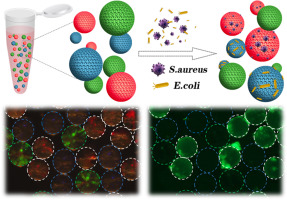Biosensors and Bioelectronics ( IF 10.7 ) Pub Date : 2017-09-20 , DOI: 10.1016/j.bios.2017.09.032 Yueshuang Xu , Huan Wang , Chengxin Luan , Yuxiao Liu , Baoan Chen , Yuanjin Zhao

|
Rapid and sensitive diagnosing hematological infections based on the separation and detection of pathogenic bacteria in the patient's blood is a significant challenge. To address this, we herein present a new barcodes technology that can simultaneously capture and detect multiple types of pathogenic bacteria from a complex sample. The barcodes are poly (ethylene glycol) (PEG) hydrogel inverse opal particles with characteristic reflection peak codes that remain stable during bacteria capture on their surfaces. As the spherical surface of the particles has ordered porous nanostructure, the barcodes can provide not only more surface area for probe immobilization and reaction, but also a nanopatterned platform for highly efficient bioreactions. In addition, the PEG hydrogel scaffold could decrease the non-specificity adsorption by its anti-adhesive effect, and the decorated aptamer probes in the scaffolds could increase the sensitivity, reliability, and specificity of the bacteria capture and detection. Moreover, the tagged magnetic nanoparticles in the PEG scaffold could impart the barcodes with controllable movement under magnetic fields, which can be used to significantly increase the reaction speed and simplify the processing of the bioassays. Based on the describe barcodes, it was demonstrated that the bacteria could be captured and identified even at low bacterial concentrations (100 CFU mL−1) within 2.5 h, which is effectively shortened in comparison with the “gold standard” in clinic. These features make the barcodes ideal for capturing and detecting multiple bacteria from clinical samples for hematological infection diagnostics.
中文翻译:

基于适体的水凝胶条形码,用于捕获和检测多种类型的病原细菌
基于患者血液中病原菌的分离和检测,快速,灵敏地诊断血液学感染是一项重大挑战。为了解决这个问题,我们在这里提出了一种新的条形码技术,该技术可以同时捕获和检测来自复杂样品的多种类型的致病细菌。条形码是聚(乙二醇)(PEG)水凝胶反蛋白石颗粒,具有特征性的反射峰编码,在细菌被其表面捕获时,它们保持稳定。由于颗粒的球形表面具有有序的多孔纳米结构,因此条形码不仅可以提供更多的表面积用于探针固定和反应,还可以提供用于高效生物反应的纳米模式平台。此外,PEG水凝胶支架通过其抗粘连作用可以减少非特异性吸附,支架上修饰的适体探针可以提高细菌捕获和检测的灵敏度,可靠性和特异性。此外,PEG支架中标记的磁性纳米粒子可以赋予条形码在磁场下可控的运动,可用于显着提高反应速度并简化生物测定的过程。根据所描述的条形码,证明了即使在低细菌浓度(100 CFU mL PEG支架中标记的磁性纳米颗粒可以赋予条形码在磁场下可控的运动,可用于显着提高反应速度并简化生物测定的过程。根据所描述的条形码,证明了即使在低细菌浓度(100 CFU mL PEG支架中标记的磁性纳米颗粒可以赋予条形码在磁场下可控的运动,可用于显着提高反应速度并简化生物测定的过程。根据所描述的条形码,证明了即使在低细菌浓度(100 CFU mL-1)在2.5小时内,与临床上的“黄金标准”相比,有效缩短了时间。这些功能使条形码非常适合从临床样本中捕获和检测多种细菌,以进行血液学感染诊断。










































 京公网安备 11010802027423号
京公网安备 11010802027423号